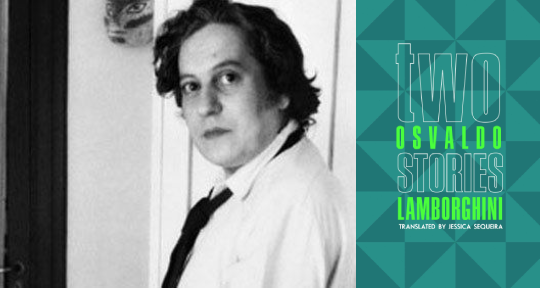Two Stories by Osvaldo Lamborghini, translated from the Spanish by Jessica Sequeira, Sublunary Editions, 2021
The subject of Osvaldo Lamborghini’s impact on Argentine Literature summons a polarity of responses. The late Leopoldo Marechal, commenting on Lamborghini’s seminal El Fiord, said: “It’s perfect. A sphere. Shame it’s a sphere of shit.” On the contrary, César Aira, Lamborghini’s mentor/curator of sorts, extrapolates his singularity—claiming his work to be unparalleled. Academics of the greatest rigor and other heavyweights of the contemporary Latin American literati—such as Tamara Kamenszain and Roberto Bolaño—have unfettered their comments on the writing of Lamborghini as well: the former finding the need to unabatedly analyze, theorize, and deconstruct the dialectic around Lamborghini’s work, and the latter encouraging the reader to enter with caution. With so much contention surrounding his oeuvre, taking on the task of translating any of Lamborghini’s work is a mighty—even ominous—task. It therefore comes to no surprise that a print translation into the English has taken a relatively long time to reach our hands, but it has arrived: Two Stories by Osvaldo Lamborghini, by the intrepid hand of translator Jessica Sequeira.
The written word, for Lamborghini, permeates the conscious with a concise and potent mechanism, boggling the minds of readers with an intelligently savage use of syntax, punctuation, and orthography. I first encountered his antics in El Fiord, his first publication. After quickly scrapping my thesaurus and dictionary, I stumbled between aversion and infatuation, rummaging through a labyrinth of blogs and academic databases for explanations and makeshift guides to the text. After a few years of indulging in the somewhat toxic relationship of attempting to translate El Fiord into English, my notes revealed that a great many elements of his writing transcend conventional translation approaches and decisions, culminating in ever more possibilities for the text. Thus, translation is an important tool for engaging the multifarious nature of Lamborghini’s work, and Two Stories demonstrates that the act of translation proves to be a helpful light while shadowboxing what some call the “untranslatable” Osvaldo Lamborghini.
It is not only Lamborghini’s quirky punctuation and witty syntax that deems his work untranslatable; the challenge lies within his deep plunge into Argentine history, politics, literature, popular culture, and identity at large. Two Stories is no exception. Each story is meticulously laced with gaucho and contemporary slang—not to mention the author’s own neologisms. Jessica Sequiera is to be commended, then, for a translation that does not break or loosen the tensions Lamborghini creates with the aforementioned layers embedded in his work, setting the state for the Anglophone community to consider how Lamborghini has set himself apart, breaking from the established literary scene. READ MORE…


